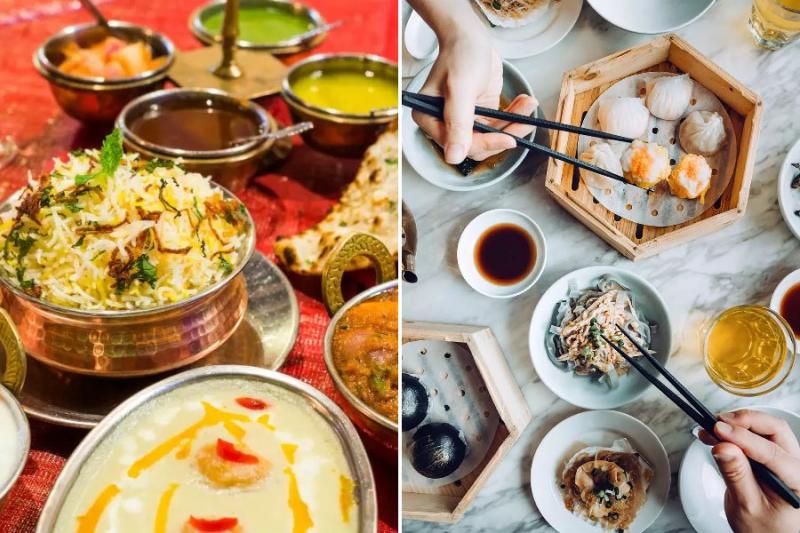The most important difference between an Indian restaurant and a Chinese restaurant is their food and cooking styles. Indian restaurants serve food with many spices, herbs, and different kinds of vegetables, grains, and proteins. Meals usually include curries, flatbreads, rice dishes, and dishes made in a tandoor oven. On the other hand, Chinese restaurants serve dishes based on Chinese cooking traditions and focus on balance, colour, and texture. Chinese food usually includes stir-fries, noodles, dumplings, and rice dishes. Soy sauce, ginger, garlic, and sesame oil are common ingredients in Chinese cooking. Both types of food have different tastes, ways of cooking, and ingredients that suit different tastes and preferences.
What is an Indian Restaurant?
An Indian restaurant is a place to eat that specialises in Indian cuisine, which has a wide range of flavours, ingredients, and cooking styles from different parts of the country. Indian cuisine is known for its extensive use of fragrant spices like cumin, coriander, turmeric, cardamom, herbs, vegetables, grains, and protein sources like poultry, meat, fish, and legumes.
Indian restaurants usually have a wide range of dishes, such as curries, flatbreads like naan and roti, rice dishes like biryani, and tandoori dishes cooked in a traditional clay oven. Indian food also has many vegetarian and vegan options and dishes and desserts made with dairy.
The menu of an Indian restaurant often reflects the different regional cooking styles of the country, from the rich, creamy dishes of the North to the tangy, spicy flavours of the South and the unique blend of East and West flavours. Indian restaurants also put a lot of thought into making meals with a good balance of sweet, sour, salty, spicy, and bitter tastes.
In short, an Indian restaurant serves various dishes and flavours from India’s diverse food culture. These dishes are made with spices, herbs, and other ingredients to suit different tastes and dietary needs.
What is a Chinese Restaurant?
A Chinese restaurant is a place to eat that specialises in Chinese food, which is known for its wide range of tastes, cooking methods, and regional differences. Chinese food is based on centuries-old traditions and focuses on balance, harmony, and how colours, smells, and textures work together.
Chinese restaurants usually have a variety of dishes, like stir-fries, noodle dishes, dumplings, and rice dishes, that use ingredients like soy sauce, ginger, garlic, and sesame oil. Cooking methods like stir-frying, steaming, and braising are often used to make dishes look attractive, taste good, and have different textures.
Menus at Chinese restaurants often reflect the different cooking styles of China’s different regions, like the spicy Sichuan food, the delicate flavours of Cantonese food, or the rich, hearty dishes of the northern regions. The seasons and fresh, local ingredients are also essential in Chinese cooking.
In conclusion, a Chinese restaurant serves various dishes that show off the different tastes, cooking methods, and regional specialities of Chinese food. It’s a place to eat that focuses on balance, harmony, and a mix of colours, smells, and textures to suit different tastes and preferences.
Difference Between Indian Restaurant and Chinese Restaurant
The primary difference between Chinese and Indian restaurants is the use of different cooking methods, spices, and ingredients. They each provide a unique dining experience firmly anchored in the culinary customs of their different regions.
Chinese restaurants provide traditional Chinese food, which places emphasis on complementary flavours and the balance of ingredients. They provide stir-fries, noodle dishes, dumplings, and rice using condiments like soy sauce, ginger, garlic, and sesame oil. Chinese cuisine uses various cooking methods to create colourful and texturally interesting meals, from stir-frying to steaming to braising. Regional cuisines from China, such as Sichuan, Cantonese, and Northern Chinese, are frequently included on menus.
Yet Indian eateries serve only Indian food, which is distinguished by its abundant use of spices, herbs, vegetables, cereals, and proteins. Curries, naan, roti, biryani, and tandoori preparations, all baked in a clay oven, are commonplace in Indian cuisine, as are various other flatbreads and rice dishes. The many regional variations in Indian cooking mean that vegetarian, vegan, and dairy-based dishes can all be found side by side. Meals are balanced with various flavours, including sweet, sour, salty, spicy, and bitter.
In conclusion, the main difference between Chinese and Indian restaurants is that they provide two very different cuisines, one celebrating Chinese and the other Indian regional culinary traditions.






